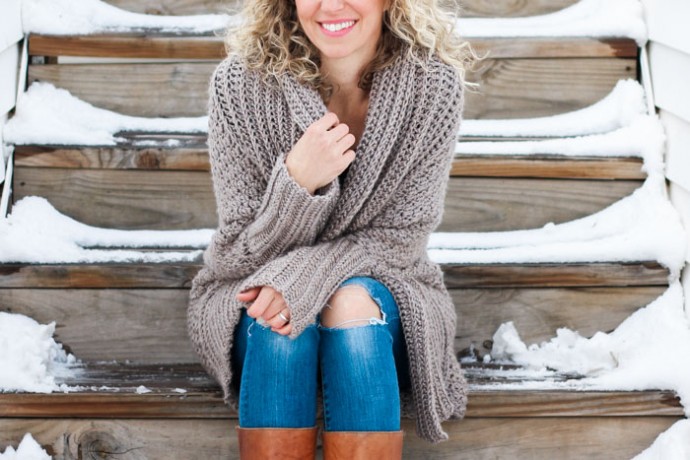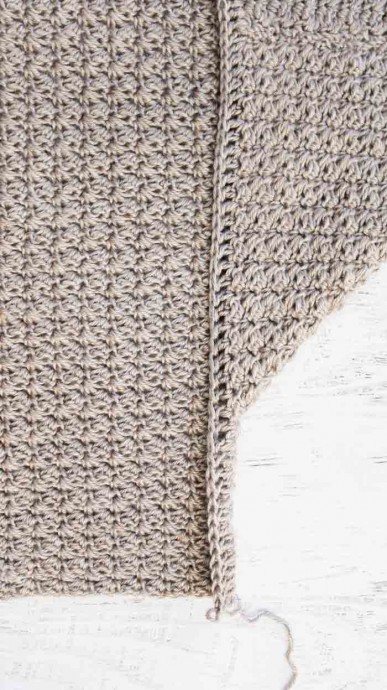Step-by-Step Crochet Instructions for a Ribbed Cocoon Sweater







You’ll Need:
6 (6, 7, 7, 8) skeins of Lion Brand Heartland (Weight: 4/medium – 251 yds, 5 oz) – Grand Canyon (#136-122);
Crochet hook 6 and 6.5 mm;
Tapestry needle;
Stitch markers;
Safety pins.
Size:
The sample is a M/L on a 5’9” model with a 36” bust.
Bust Size:
- S/M: 33-36”
- M/L: 36-40.5”
- L/XL: 40.5”-44.5”
- XL/2XL: 44.5”-48.5”
- 2XL/3XL: 48.5”-51”
Stitches Control:
10 sts x 10 rows = 4”
Instructions
Adding Ribbed Cocoon Collar
Notes: The collar is worked along the edge of the shrug/tush extension back and forth in rows starting at the bottom front corner of the sweater, working around the back of the neck and returning to the bottom front corner on the other side.
When working Row 1, be more concerned with evenly spacing the hdc stitches so that the resulting collar looks smooth rather than the total stitch count.
Ch 2 at the beginning of each row does not count as a hdc.
Use a larger hook. With RS of fabric facing you, continue using the yarn strand from the tush extension.
Row 1:
Ch 2, work hdc stitches evenly from the bottom collar corner to the opposite corner. To do this: hdc in each row of the tush extension, then hdc in each st along the collar edge and again hdc in each row of the tush extension of the opposite side; turn.
Row 2:
Ch 2, hdcflo in each hdc to end of row; turn.
Rep Row 2 22 (24, 24, 26, 26) more times to create a total of 12 (13, 13, 14, 14) visible ribbing “bumps” or rows of “V’s” running along the collar. Fasten off.
Sleeves
Notes:
Sleeves are worked flat and then seamed into tubes.
As in the collar, the ch 2 at the beginning of the row does not count as a stitch.
Use a smaller hook. Make 2.
Foundation Row:
Ch 28 (32, 32, 32, 32).
Row 1:
Sk 2 ch, hdc in each ch; turn. 26 (30, 30, 30, 30)
Row 2:
Ch 2, hdcflo in each hdc; turn.
Rep Row 2 16 (18, 18, 20, 20) more times to create a total of 9 (10, 10, 11, 11) visible ribbing “bumps” or rows of “V’s” running in the sleeve rectangle. Fasten off leaving a 24” tail for seaming.
Seaming Sleeves
Lay the sleeve rectangle with WS facing you (this will become the RS of the sleeves when the sweater is finished) and the foundation ch oriented to the top of the rectangle. Fold the sleeve so the foundation ch and final row of the sleeve are touching.
Use a single strand tail from fastening off and a tapestry needle. Seam the sleeve by sewing through the two vertical posts of each st in Row 1 and the two back loops of each hdc st of the last row. (See photo below.) The purpose of seaming this way is to best hide the seam within the sleeve ribbing. Do not fasten off yarn. Repeat with the second sleeve. Do not turn the sleeves inside out.
Attaching Sleeves
Turn the main sweater inside out. If you’re confused by what is the RS and WS at any point, look at the place where the hdc collar edge meets the sweater. It should look like a smooth transition on the RS of the sweater and a little rougher on the WS.
Lay the sweater and sleeve as pictured in the photo above. Pin with stitch markers if desired. With the tail left over from seaming the sleeve, use the mattress stitch to join the sleeve to the sweater. Fasten off. Repeat with the second sleeve. Turn the sweater right side out.
